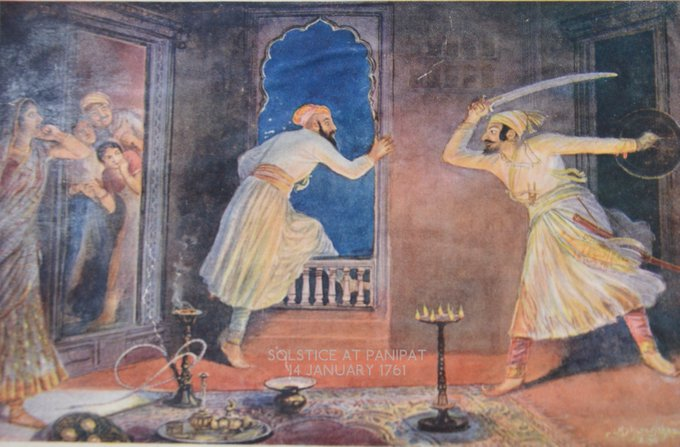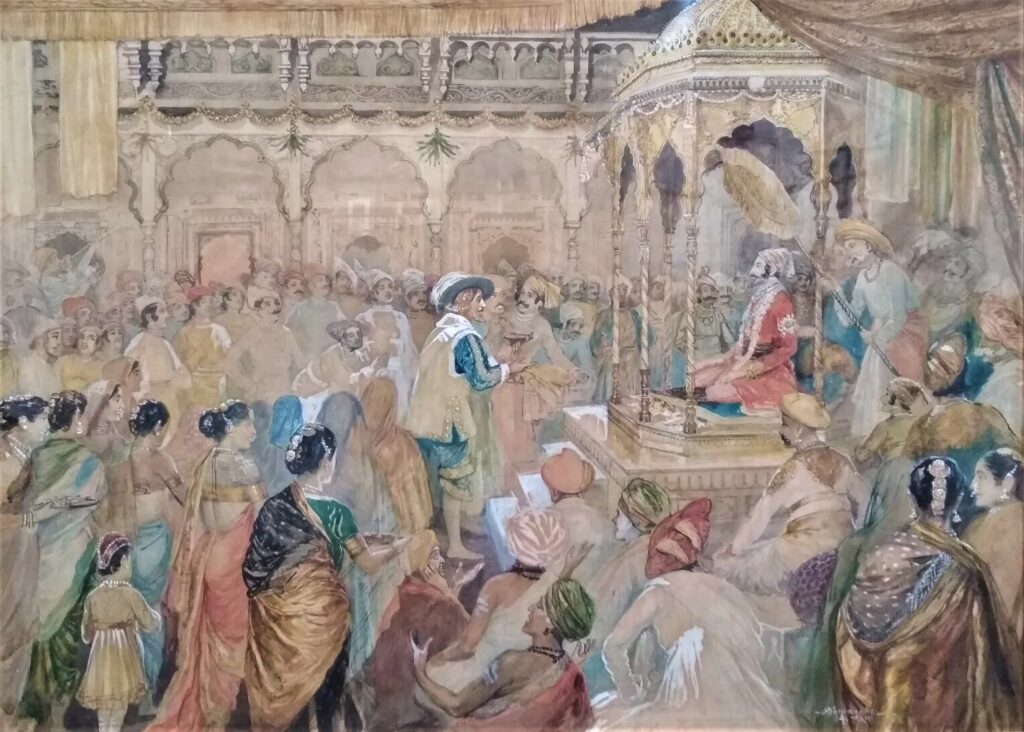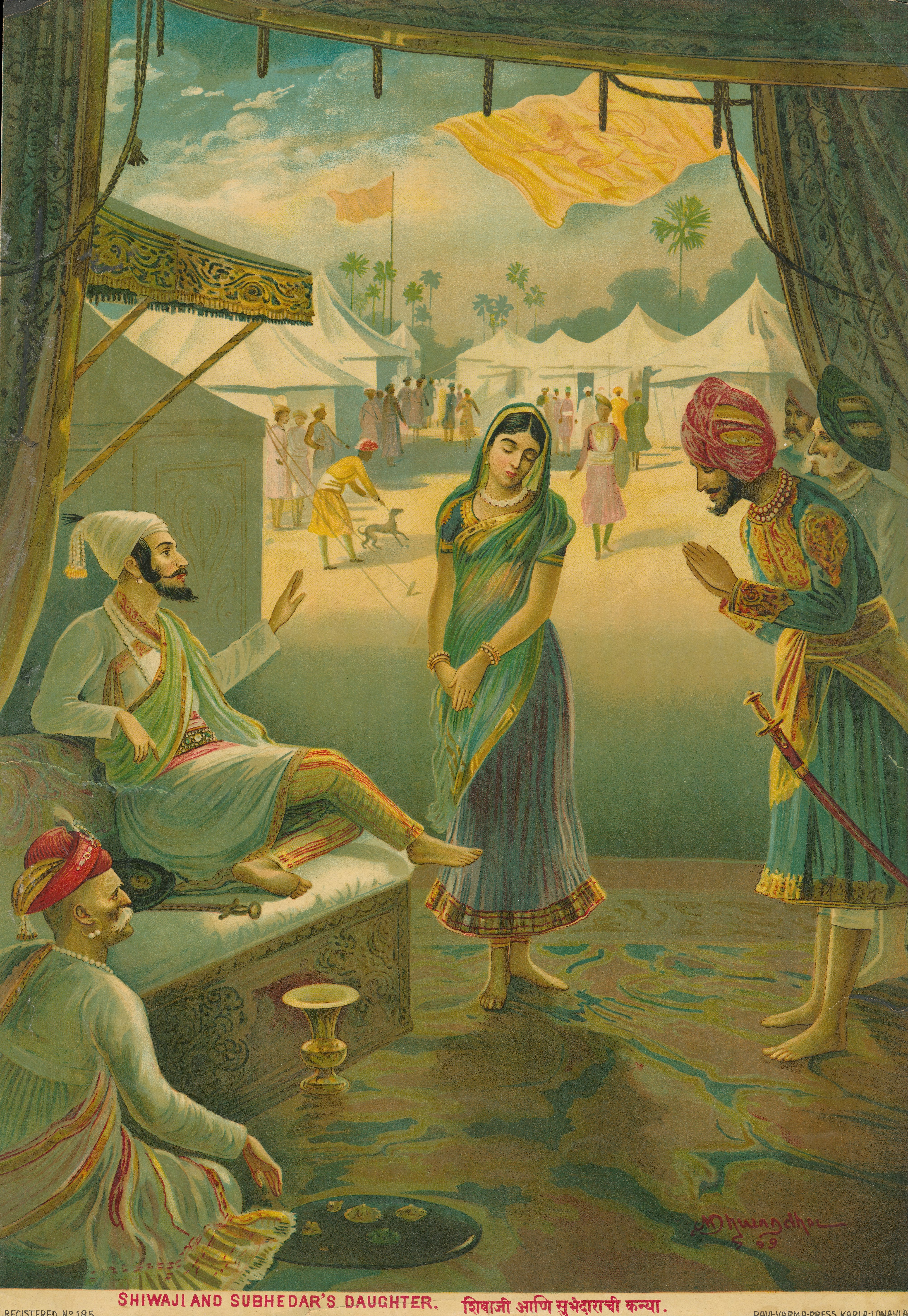Shivaji Maharaj Full Body Drawing
Chhatrapati Shivaji Maharaj was a man of great valour, a charismatic leader and the founder of the Maratha Empire. Endless stories of his wit, authoritative abilities, resourcefulness and bravery have been told through novels, comics, plays, ballads, songs, and visual art and have inspired generations.
Interestingly, unlike usual practice in imperial courts, Shivaji did not apply artists or painters. Yet, in visual fine art itself in that location are numerous depictions of Shivaji – in miniatures, sculptures as well equally modern art. In the 19th century painter, M.V Dhurandhar'due south works, there are several watercolour paintings featuring Shivaji Maharaj.
Co-ordinate to the Bhau Daji Lad Museum that exhibited these works in 2018 equally part of an exhibition:
These are illustrations from books commissioned past Balasaheb Pantapratinidi, Raja of Aundh. These works resulted from the numerous trips Dhurandhar made with Purshottam Mawji, who wrote a history of Shivaji Maharaj'south military and its role during warfare.
Source
In the study of Indian art history, painters of 19th and 20th century Mumbai agree a special place. Amongst them, M.Five Dhurandhar was one of the foremost and most pregnant artists, maintaining a fine balance between academic realism and pop commercial fine art. He studied at the Sir J. J. School of Art between 1890 and 1895 and went on to go its first Indian managing director (1919 -1935). Particularly skilled with watercolours, Dhurandhar was an illustrator and portraitist of great repute. His well-known works included a series on the city of Mumbai and its people, scenes from Hindu mythology as well as a series on the Rubaiyat of Omar Khayyam.

In a series of paintings featuring Shivaji Maharaj, M.V Dhurandhar captures the valour, aureola and a humanitarian side of the Maratha Rex.

Shivaji, the bully Maratha warrior king, (named after the goddess Shivai) was born to Shahaji Bhosale & Jijabai at a time when power in Deccan was shared by iii sultanates: Bijapur, Ahmednagar, and Golkonda. Shahaji Bhosale served as a general in the Deccan Sultanate and maintained his own pocket-sized kingdom in Pune even every bit he was stationed at different locations. Shivaji grew up in Pune under the care of his mother. Over the subsequent years, he helmed the reign of the Maratha Empire. He established a competent and progressive civil rule with well-structured administrative organisations. Shivaji's military forces expanded the Maratha sphere of influence, capturing and building forts, and forming a Maratha navy.
Here are some paintings depicting cardinal moments from the life of Chhatrapati Shivaji Maharaj. Let's accept a look!
1. Escape from Panhala : Shivaji inspired loyalty
This painting features Baji Prabhu and a small group of Shivaji's followers who gave up their lives to protect him. Information technology captures the essence of the Shivaji's ardent followers who were loyal and prepare to lay down their lives, fighting for his safety. Later, Shivaji would honour their sacrifice by immortalizing their memory.

The backstory: In 1660, Shivaji Maharaj was trapped in the fort of Panhala, under siege and vastly outnumbered by an Adilshahi ground forces from Bijapur led by Siddhi Johar. The Adilshahi had suffered several defeats from Shivaji in the past. Despite being at odds with Mughals, they joined hands to derail Shivaji from his ambition and seek revenge. To escape from Panhala, Shivaji hatched a high-chance (and audacious) plan and high-hazard plan. Along with his commander Baji Prabhu Deshpande and a select band of troops, they attempted to suspension through the siege at nighttime and brand for Vishalgad. In gild to deceive the Bijapuri forces, Shiva Nhavi, who had an uncanny concrete resemblance to Shivaji, volunteered to wearing apparel like the male monarch and let himself be captured. His sacrifice lent the fleeing Maratha force some more than time. Baji Prabhu decided to stay back with half of the troops while Shivaji marched forward with the other one-half. Baji, his brother Phulaji and the remaining Bandal Sena of near three hundred men blocked the route and fought against thousands of Bijapuri soldiers in the Ghodkhind Pass for more than eighteen hours. The Ghodkhind pass was subsequently named Pavan Khind ("Holy Pass") by Shivaji, in honor of the sacrifice of Baji Prabhu and his troops. Now known equally the 'Battle of Pavan Khind'.
two. Shaista Khan Surprised : Shivaji'southward fearlessness
This painting recalls the time (April 1663) when Shivaji launched a surprise set on on Shaista Khan in Pune, forth with a small group of men. After gaining access to Khan's compound, the raiders were able to seize control. Shaista Khan made a narrow escape from the grasp of Shivaji, losing a finger in the confrontation. Looking at the painting, information technology is apparent that Shaista Khan was enjoying his treats (or hookah) before he saw Shivaji and ran towards the window to escape. Dhurandhar has skillfully rendered all the elements together to portray the tension of the moment; Shaista Khan's fearful expression heightens expression, which heightens the sense of drama of the 'surprise'.

The backstory: Until 1657, Shivaji maintained peaceful relations with the Mughal Empire. He even offered his assistance to Aurangzeb in conquering Bijapur in return for formal recognition of his right to the Bijapuri forts and villages under his possession. Dissatisfied with the Mughal response, he launched a raid into the Mughal Deccan. Upon the request of Badi Begum of Bijapur, Aurangzeb sent his maternal uncle Shaista Khan, with an regular army numbering over 150,000 along with a powerful artillery segmentation in Jan 1660 to assault Shivaji combined with Bijapur's army led by Siddi Jauhar. He pressed his advantage of having a larger, amend provisioned and heavily armed Mughal army and made inroads into some of the Maratha territory, seizing the metropolis of Pune and establishing his residence at Shivaji'due south palace of Lal Mahal.
3. Campaign for Kondana (Sinhagad) fort: Shivaji's friendships were potent
This painting features Shivaji, his mother Jijabai and 1 of his generals and close friends, Tanaji Malusare. Shivaji's mother Jijabai occupies the central position in this scene and seems to exist giving her blessings to Tanaji – when he takes his famous vow.
The backstory: The story of this painting dates back to 1665, when the fort of Kondana was acceded to the Mughals as a part of the Treaty of Purandar. Shivaji was disappointed about losing such a strategically important fortification, which is visible in his torso language. With an aim to recapture the fort, Shivaji called his generals and discussed this chore. Amidst them was Tanaji Malusare, who agreed to take upwards the challenge. At present Tanaji was actually visiting to invite Shivaji to his son Rayba's nuptials. After reading the invitation, Shivaji implored upon Tanaji to focus on his son's wedding, assuring that he would give this task to someone else. However, Tanaji, adamant as always, took a vow for the Kondana campaign saying:
"Aadhi lagin kondhanyache magazine mazya Raybache"
(I'll capture Kondana beginning, Rayba's spousal relationship tin can happen afterward).
The confidence on Tanaji'south face is well documented in this painting. The 'Battle of Sinhgad' took identify during the night on 4 February 1670 on the fort of Sinhagad (so known as Kondana), well-nigh the urban center of Pune. The boxing was fought between Tanaji Malusare, (commander of the Maratha Empire under Shivaji) and Uday Bhan Singh Rathore, a Rajput fort keeper nether Jai Singh I (who worked for the Mughal emperor Aurangzeb). Fifty-fifty every bit the boxing unfolded in favour of the Maratha regular army who won the Fort, Tanhaji was killed.
The boxing and Tanaji'south exploits are still a popular subject for Marathi ballads. Information technology is said that when Shivaji got the information nearly the victory just Tanaji lost his life during the battle, he exclaimed "Gad ala pan sinh gela" (The fort has been captured simply we lost the panthera leo). A bust of Tanaji Malusare was established on the fort in the memory of his contribution to the boxing. The fort was as well renamed Sinhgad to award his memory.
4. On the way to Purandar Fort: Shivaji was a practical leader
This painting features Shivaji acknowledging the greetings of the people on the way, to Purandar Fort (and perhaps reassuring them). This fort had special relevance in Shivaji's ascension every bit a King : as a young warrior, Shivaji had raided and captured the fort of Purandar in 1646. It was one of his first victories for the Maratha empire; moreover, his commencement son Sambhaji had been born at Purandar Fort.

The backstory: In 1665, the forces of Aurangzeb besieged the Purandar Fort under the control of Mirza Raje Jai Singh assisted by Diler Khan. The killedar (keeper of the fort), Murarbaji Deshpande of Mahr offered strong resistance against the Mughal forces ultimately giving upwardly his life in a struggle to retain the fort. When Shivaji learned virtually the loss of Murarbaji and the prospect of the autumn of his granddad's fort, he embarked on a journey to the Purandar fort filled with resolve to observe a solution to the situation.
In order to make peace, Shivaji had to sign a treaty known as the 'First Treaty of Purandar' with Jai Singh on 11 June 1665. According to the treaty, Shivaji had to hand over twenty-three forts including Purandar, keeping twelve forts for himself and pay a compensation of 400,000 gold mohurs to the Mughals. Shivaji agreed to get a vassal of the Mughal empire, and to transport his son Sambhaji to fight for the Mughals in the Deccan equally a mansabdar along with 5,000 horsemen.
5. When Shivaji was invited past Aurangzeb to Agra : Shivaji had immense pride and self-respect
In this painting, Dhurandar has featured one of the almost dramatic moments in Shivaji's life. If y'all expect closer at the painting, the courtiers, the guards, piddling Sambhaji, the others – they are all in stupor at the audacity of Shivaji to speak in the Emperor's presence. Aurangzeb has been restricted to one side of the painting, whereas Shivaji occupies the centre stage and dominates the narrative.

The backstory: After signing the Treaty of Purandar, Shivaji agreed to fall in line with the orders of the Mughal empire. He and his son, Sambhaji were summoned by the Mughal emperor Aurangzeb to Agra in 1666. Aurangzeb's programme was to deploy Shivaji at Kandahar to consolidate the northwestern frontier of the Mughal empire. However, Aurangzeb fabricated Shivaji stand up behind the mansabdārs of his court. Being a man of pride, Shivaji took offence at this handling, protested in his defence and stormed out. As a result, he was placed under house abort under the watch of Faulad Khan, Kotwal of Agra. Shivaji'due south position under house abort was perilous, as Aurangzeb's courtroom debated whether to kill him or proceed to employ him. Meanwhile, Shivaji used his dwindling funds to bribe courtiers to support his case. Orders came from the emperor to station Shivaji in Kabul, which he refused. Instead he asked for his forts to be returned and to serve the Mughals as a mansabdār. Aurangzeb refused and said that he must surrender his remaining forts before returning to Mughal service. Unable to give into the emperor'southward demands, Shivaji managed to escape from Agra, likely by bribing the guards. According to a pop fable, it is believed that Shivaji and his son escaped in large baskets, that were claimed to be sweets to be gifted to religious figures in the city. Although, the Mughal Emperor was never able to ascertain how he escaped despite an investigation.
6. Coronation of Shivaji : How Shivaji became 'Chhatrapati Shivaji Maharaj'
This painting shows the coronation of Chhatrapati Shivaji Maharaj and is filled with people. The painter does non really focus on the interiors but instead focuses on the 'oversupply' that had gathered at the event. Look closer and yous'd realise that every face in this painting is distinct; no 2 women are dressed similarly nor practise whatever faces look the aforementioned. In the painting you tin also spot Gaga Bhatt (a renowned priest from Banaras who officiated the ceremony) advancing the golden umbrella over Shivaji's head. There is also an unidentified British official seen extending his greeting to the recently crowned rex.

The backstory: Though Shivaji had acquired all-encompassing lands and wealth through his conquests, he lacked a formal championship. This meant that technically he was still a Mughal zamindar or the son of a Bijapuri jagirdar, with no legal basis to rule his de facto domain. A royal championship would address this and likewise prevent whatever challenges by other Maratha leaders (to who he was an equal). It would besides provide the Hindu Marathas with a beau Hindu sovereign in a region otherwise ruled past Muslims.
Shivaji was crowned male monarch of Maratha Swaraj in a lavish ceremony on half dozen June 1674 at Raigad fort and became the first Chhatrapati of the Maratha Empire.
Shivaji was a staunch supporter of women and their honour. During his rule women were protected and their dishonor was non taken lightly. He opposed all kinds of violence and harassment against women.

Under Shivaji's rule, anyone caught violating women's rights was severely punished. In fact, women of captured territories were also released unharmed, and with integrity. An example of this can exist seen in this painting which shows Shivaji receiving the daughter-in-law of the Subedar of Kalyan, who had been defeated in a boxing. While the story of the Subedar'due south daughter-in-law is widely believed to exist a legend and is not a historical fact, Shivaji'due south support for women is undeniable.
Enjoyed reading? Consider subscribing for cultural content in your inbox!
Source: https://www.theheritagelab.in/shivaji-maharaj-paintings-dhurandhar/
0 Response to "Shivaji Maharaj Full Body Drawing"
Post a Comment